Electronic Tabletop Holographic Display: Design, Implementation, and Evaluation
Abstract
:1. Introduction
2. Prior Art of Holographic Display Implementation
3. Design Concept and Methodologies
- (1)
- The size of the hologram image should be reasonably big enough so that viewers can perceive the 3-dimentional volume and some details of the image.
- (2)
- The hologram image should be seen by multiple viewers at the same time, and freely from different positions and perspectives so that each viewer can easily perceive the whole shape of rendered objects and all viewers can share the whole scene information in order to discuss about, or collaboratively manipulate, on it.
- (3)
- The image should be rendered in such a way that binocular disparity and motion parallax is perceived to a satisfactory level. In other words, the image should deliver the perception of real objects being there, showing all around perspective views of the object with full parallax.
- (4)
- No physical apparatus of the display should occupy the image space, so that the hologram image is shown in free air, enabling manipulation or interaction with the image as if we do with real objects.
- (5)
- High quality color hologram image with dynamic content, i.e., the hologram video should be presented.
- (1)
- Image size is first enlarged by simple optical magnification using 4-f optics, which results in enlarged virtual SLM (from 1.27 cm to 7.62 cm). The price of this image enlargement is reduced diffraction angle of the virtual enlarged SLM (from 2° to 0.3°).
- (2)
- We make a viewing window at viewing distance of 900 mm by adding a field lens in the position of virtual SLM plane, forming the size of 4.7 mm × 4.7 mm rectangular viewing window.
- (3)
- Seamless horizontal viewing zone is made by circularly tiling the viewing windows of the appropriate number of viewpoint-dependent hologram images. In our system, the viewing zone has a circumferential length of ~4000 mm, which can be covered by tiling more than 851 viewing windows. In actual implementation, 1024 viewing windows are tiled with some overlap between adjacent ones. This is achieved by temporal multiplexing with mechanical scanning optics.
- (4)
- The viewpoint-dependent hologram images are designed to be seen at the center of the tabletop display, so that coalition of them makes a volumetric 3-dimentional image floating in the air. This is achieved by two stages of optics. In the first stage, the light path of the hologram image is guided by a combination of flat mirrors into 45-degree slanted direction and in a way to overlap at the axial area of the system. In the second stage, these virtual SLM planes are transported to the top center area of the tabletop display (final hologram image plane in the air above the tabletop of the display) by image transportation function of double parabolic mirrors from one focal area to another. This is shown in Figure 5.
- (1)
- The SLM module for color hologram generation is designed using three DMDs for each monocolor (R, G, and B) hologram, combining optics consisting of two prisms (one is trichroic and the other is TIR (total internal reflection) type), and three laser light sources with collimated beam output. In this way we preserve the image resolution of the monocolor display in color holographic display. Refer to [22] for some implementation details.
- (2)
- We have thus far a vertically narrow (4.7 mm) viewing stripe around and over the display. A vertical viewing angle of 20° is also required in order to permit the viewers’ free position or posture (sitting on a chair, standing, or somewhere in between, as shown in Figure 2b) to view the hologram image, and this is achieved by adding vertical diffuser optics (a lenticular sheet, which is schematically shown in Figure 5) at the virtual SLM plane. Since diffusing optics degrades the spatial focusing capability of hologram somewhat, there is a tradeoff in this regard.
- (3)
- Vertical parallax is added inside this 20° of vertical viewing range (between 35° and 55° from the tabletop). For this, precise and fast pupil tracking of viewers with a dynamic update of the hologram images is implemented for a limited number of viewers. Pupil tracking module consists of multiple IR illuminator and cameras. Two cameras working as a stereo camera covers a viewer in 90° range, and four camera sets are used for 360° coverage, while supporting four viewers simultaneously. Figure 6 shows the working concept of the module and experimental setup for 180° coverage with reconstructed image at four different vertical positions. Currently, update of pupil position is limited to 10 times per second, which is not sufficient for smooth update of hologram images following viewer’s motion.
- (4)
- Capture of 3D information from moving real objects and the 360-degree perspective hologram CGH is implemented, and thus the signal chain from capture-CGH to display is demonstrated.
4. Implementation and Experimental Result
5. Measurements and Evaluation
5.1. Size of the Image Volume Space
5.2. Hologram Image Resolution
5.3. Color Gamut and Color Reproduction Fidelity
5.4. Speckle Noise
5.5. Degree of Depth of Focus (DoF)
6. Conclusions
Author Contributions
Funding
Acknowledgments
Conflicts of Interest
Appendix A
| depth | 20 | 40 | 60 | 80 | 100 | 120 |
| max | 0.519 | 0.576 | 0.572 | 0.551 | 0.551 | 0.581 |
| mean | 0.467 | 0.533 | 0.525 | 0.521 | 0.527 | 0.529 |
| min | 0.433 | 0.482 | 0.494 | 0.468 | 0.490 | 0.511 |
| SP# | 1 | 2 | 3 | 4 | 5 | 6 | 7 | 8 | 9 | 10 | 11 | 12 | 13 | 14 | average | Stdev |
| 20 | 0.459 | 0.458 | 0.447 | 0.461 | 0.454 | 0.469 | 0.475 | 0.498 | 0.484 | 0.519 | 0.433 | 0.453 | 0.449 | 0.474 | 0.467 | 0.022 |
| 40 | 0.527 | 0.545 | 0.550 | 0.543 | 0.576 | 0.523 | 0.542 | 0.521 | 0.482 | 0.519 | 0.529 | 0.537 | 0.530 | 0.533 | 0.022 | |
| 60 | 0.518 | 0.507 | 0.532 | 0.526 | 0.529 | 0.504 | 0.572 | 0.528 | 0.494 | 0.528 | 0.531 | 0.505 | 0.561 | 0.509 | 0.525 | 0.022 |
| 80 | 0.497 | 0.551 | 0.523 | 0.533 | 0.516 | 0.536 | 0.541 | 0.546 | 0.484 | 0.518 | 0.468 | 0.542 | 0.521 | 0.026 | ||
| 100 | 0.545 | 0.536 | 0.517 | 0.547 | 0.526 | 0.551 | 0.515 | 0.499 | 0.519 | 0.529 | 0.536 | 0.544 | 0.490 | 0.527 | 0.019 | |
| 120 | 0.520 | 0.521 | 0.524 | 0.541 | 0.517 | 0.524 | 0.527 | 0.523 | 0.581 | 0.511 | 0.532 | 0.526 | 0.529 | 0.018 |
| depth | 20 | 40 | 60 | 80 | 100 | 120 |
| max | 0.286 | 0.418 | 0.400 | 0.396 | 0.402 | 0.393 |
| mean | 0.259 | 0.393 | 0.370 | 0.377 | 0.374 | 0.381 |
| min | 0.217 | 0.372 | 0.336 | 0.357 | 0.336 | 0.369 |
| SP# | 1 | 2 | 3 | 4 | 5 | 6 | 7 | 8 | 9 | 10 | 11 | 12 | 13 | 14 | average | Stdev |
| 20 | 0.286 | 0.260 | 0.276 | 0.247 | 0.284 | 0.271 | 0.243 | 0.262 | 0.279 | 0.252 | 0.251 | 0.260 | 0.217 | 0.231 | 0.259 | 0.020 |
| 40 | 0.405 | 0.418 | 0.400 | 0.413 | 0.400 | 0.393 | 0.394 | 0.380 | 0.378 | 0.382 | 0.372 | 0.383 | 0.391 | 0.393 | 0.014 | |
| 60 | 0.375 | 0.369 | 0.400 | 0.363 | 0.383 | 0.371 | 0.388 | 0.370 | 0.359 | 0.373 | 0.366 | 0.336 | 0.365 | 0.360 | 0.370 | 0.015 |
| 80 | 0.359 | 0.396 | 0.376 | 0.387 | 0.381 | 0.382 | 0.386 | 0.382 | 0.365 | 0.363 | 0.357 | 0.385 | 0.377 | 0.013 | ||
| 100 | 0.388 | 0.370 | 0.378 | 0.402 | 0.380 | 0.368 | 0.392 | 0.361 | 0.383 | 0.368 | 0.363 | 0.368 | 0.336 | 0.374 | 0.017 | |
| 120 | 0.369 | 0.370 | 0.382 | 0.384 | 0.387 | 0.393 | 0.383 | 0.382 | 0.387 | 0.370 | 0.383 | 0.382 | 0.381 | 0.008 |
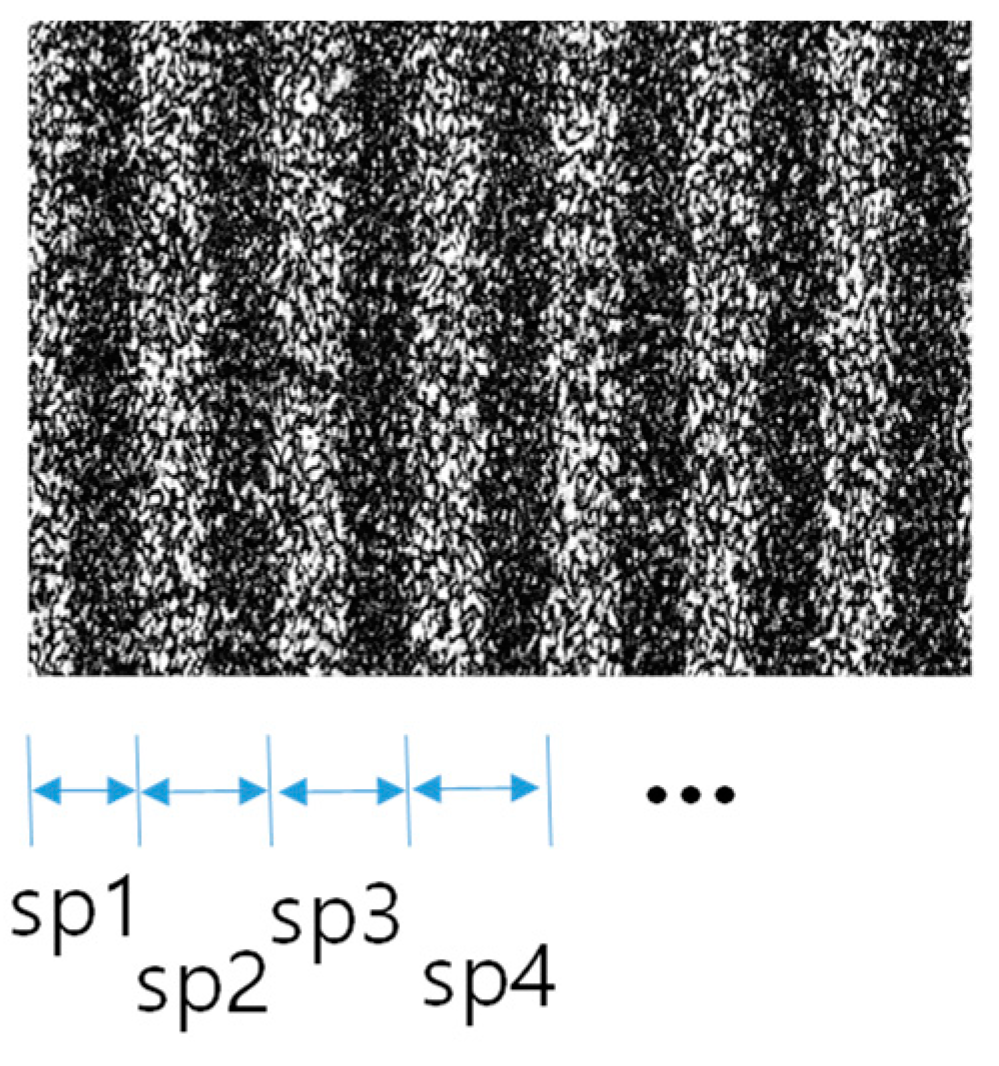
References
- Lim, Y.; Hong, K.; Kim, H.; Kim, H.-E.; Chang, E.-Y.; Lee, S.; Kim, T.; Nam, J.; Choo, H.-G.; Kim, J.; et al. 360-degree tabletop electronic holographic display. Opt. Express 2016, 24, 24999–25009. [Google Scholar] [CrossRef] [PubMed]
- St-Hilaire, P.; Benton, S.A.; Lucente, M.E.; Jepsen, M.L.; Kollin, J.; Yoshikawa, H.; Underkoffler, J.S. Electronic display system for computational holography. In Proceedings of the SPIE, Los Angeles, CA, USA, 18–19 January 1990; pp. 174–182. [Google Scholar]
- Smalley, D.E.; Smithwick, Q.Y.J.; Bove, V.M.; Barabas, J.; Jolly, S. Anisotropic leaky-mode modulator for holographic video displays. Nature 2013, 498, 313–317. [Google Scholar] [CrossRef] [PubMed]
- Häussler, R.; Reichelt, S.; Leister, N.; Zschau, E.; Missbach, R.; Schwerdtner, A. Large real-time holographic displays: From prototypes to a consumer product. IS&T/SPIE Electron. Imaging 2009, 7237, 72370. [Google Scholar]
- Hahn, J.; Kim, H.; Lim, Y.; Park, G.; Lee, B. Wide viewing angle dynamic holographic stereogram with a curved array of spatial light modulators. Opt. Express 2008, 16, 12372–12386. [Google Scholar] [CrossRef] [PubMed]
- Senoh, T.; Mishina, T.; Yamamoto, K.; Oi, R.; Kurita, T. Viewing-Zone-Angle-Expanded Color Electronic Holography System Using Ultra-High-Definition Liquid Crystal Displays with Undesirable Light Elimination. J. Display Technol. 2011, 7, 382–390. [Google Scholar] [CrossRef]
- Oi, R.; Sasaki, H.; Wakunami, K.; Ichihashi, Y.; Senoh, T.; Yamamoto, K. Large size three-dimensional video by electronic holography using multiple spatial light modulators. Sci. Rep. 2014, 4, 6177. [Google Scholar] [Green Version]
- Takaki, Y.; Okada, N. Hologram generation by horizontal scanning of a high-speed spatial light modulator. Appl. Opt. 2009, 48, 3255–3260. [Google Scholar] [CrossRef] [PubMed]
- Takaki, Y.; Matsumoto, Y.; Nakajima, T. Color image generation for screen-scanning holographic display. Opt. Express 2015, 23, 26986–26998. [Google Scholar] [CrossRef] [PubMed]
- Blanche, P.-A.; Bablumian, A.; Voorakaranam, R.; Christenson, C.; Lin, W.; Gu, T.; Flores, D.; Wang, P.; Hsieh, W.-Y.; Kathaperumal, M.; et al. Holographic three-dimensional telepresence using large-area photorefractive polymer. Nature 2010, 468, 80–83. [Google Scholar] [CrossRef] [PubMed]
- Park, M.; Chae, B.G.; Kim, H.; Hahn, J.; Moon, K.; Moon, K.; Kim, J. Digital Holographic Display System with Large Screen Based on Viewing Window Movement for 3D Video Service. ETRI J. 2014, 36, 232–241. [Google Scholar] [CrossRef]
- Blinder, D.; Ahar, A.; Bettens, S.; Birnbaum, T.; Symeonidou, A.; Ottevaere, H.; Schretter, C.; Schelkens, P. Signal processing challenges for digital holographic video display systems. Signal Process. Image Commun. 2019, 70, 114–130. [Google Scholar] [CrossRef]
- Kawashima, T.; Kakue, T.; Nishitsuji, T.; Suzuki, K.; Shimobaba, T.; Ito, T. Aerial projection of three-dimensional motion pictures by electro-holography and parabolic mirrors. Sci. Rep. 2015, 5, 11750. [Google Scholar] [Green Version]
- Inoue, T.; Takaki, Y. Table screen 360-degree holographic display using circular viewing-zone scanning. Opt. Express 2015, 23, 6533–6542. [Google Scholar] [CrossRef] [PubMed]
- Sando, Y.; Barada, D.; Yatagai, T. Holographic 3D display observable for multiple simultaneous viewers from all horizontal directions by using a time division method. Opt. Lett. 2014, 39, 5555. [Google Scholar] [CrossRef] [PubMed]
- Jones, A.; McDowall, I.; Yamada, H.; Bolas, M.; Debevec, P. Rendering for an Interactive 360° Light Field Display. ACM Trans. Graph. 2007, 26, 40. [Google Scholar]
- Butler, A.; Hilliges, O.; Izadi, S.; Hodges, S.; Molyneaux, D.; Kim, D.; Kong, D. Vermeer: Direct Interaction with a 360° Viewable 3D Display. In Proceedings of the ACM Symposium on User Interface Software and Technology, Santa Barbara, CA, USA, 16–19 October 2011. [Google Scholar]
- Yoshida, S. fVisiOn: 360-degree viewable glasses-free tabletop 3D display composed of conical screen and modular project arrays. Opt. Express 2016, 24, 13194–13203. [Google Scholar] [CrossRef] [PubMed]
- Takaki, Y. High-Density Directional Display for Generating Natural Three-Dimensional Images. Proc. IEEE 2006, 94, 654–663. [Google Scholar] [CrossRef]
- Takaki, Y.; Nago, N. Multi-projection of lenticular displays to construct a 256-view super multi-view display. Opt. Express 2010, 18, 8824–8835. [Google Scholar] [CrossRef]
- Hua, H.; Javidi, B. A 3D integral imaging optical see-through head-mounted display. Opt. Express 2014, 22, 13484. [Google Scholar] [CrossRef]
- Kim, J.; Hong, K.; Lim, Y.; Kim, J.-H.; Park, M. Design options for 360 degree viewable table-top digital color holographic displays. In Proceedings of the SPIE Commercial + Scientific Sensing and Imaging, Orlando, FL, USA, 15–19 April 2018. [Google Scholar]
- Chang, E.-Y.; Choi, J.; Lee, S.; Kwon, S.; Yoo, J.; Choo, H.-G.; Kim, J. 360-degree Color Hologram Generation for Real 3-D Object. Dig. Holography Three-Dimens. Imaging 2018, 57, A91–A100. [Google Scholar] [CrossRef]
- Seo, W.; Song, H.; An, J.; Seo, J.; Sung, G.; Kim, Y.-T.; Choi, C.-S.; Kim, S.; Kim, H.; Kim, Y.; et al. Image Quality Assessment for Holographic Display. In Proceedings of the IS&T International Symposium on Electronic Imaging 2017, Burlingame, CA, USA, 29–31 January 2017. [Google Scholar]
- Yoshikawa, H.; Yamaguchi, T. Image Quality Evaluation of a Computer-Generated Hologram. In Proceedings of the Digital Holography & 3-D Imaging Meeting, Orlando, FL, USA, 25–28 June 2018. [Google Scholar]
- Hilaire, P.S. Modulation transfer function and optimum sampling of holographic stereograms. Appl. Opt. 1994, 33, 768–774. [Google Scholar] [CrossRef]
- Ong, D.C.; Solanki, S.; Liang, X.; Xu, X. Analysis of laser speckle severity, granularity, and anisotropy using the power spectral density in polar-coordinate representation. Opt. Eng. 2012, 51, 054301. [Google Scholar] [CrossRef]
- Takaki, Y.; Yokouchi, M. Speckle-free and grayscale hologram reconstruction using time-multiplexing technique. Opt. Express 2011, 19, 7567–7579. [Google Scholar] [CrossRef] [PubMed]
- Makowski, M. Minimized speckle noise in lens-less holographic projection by pixel separation. Opt. Express 2013, 21, 29205–29216. [Google Scholar] [CrossRef] [PubMed]
- Lim, Y.; Park, J.; Hahn, J.; Kim, H.; Hong, K.; Kim, J. Reducing speckle artifacts in digital holography by the use of programmable filtration. ETRI J. 2019. [Google Scholar] [CrossRef]
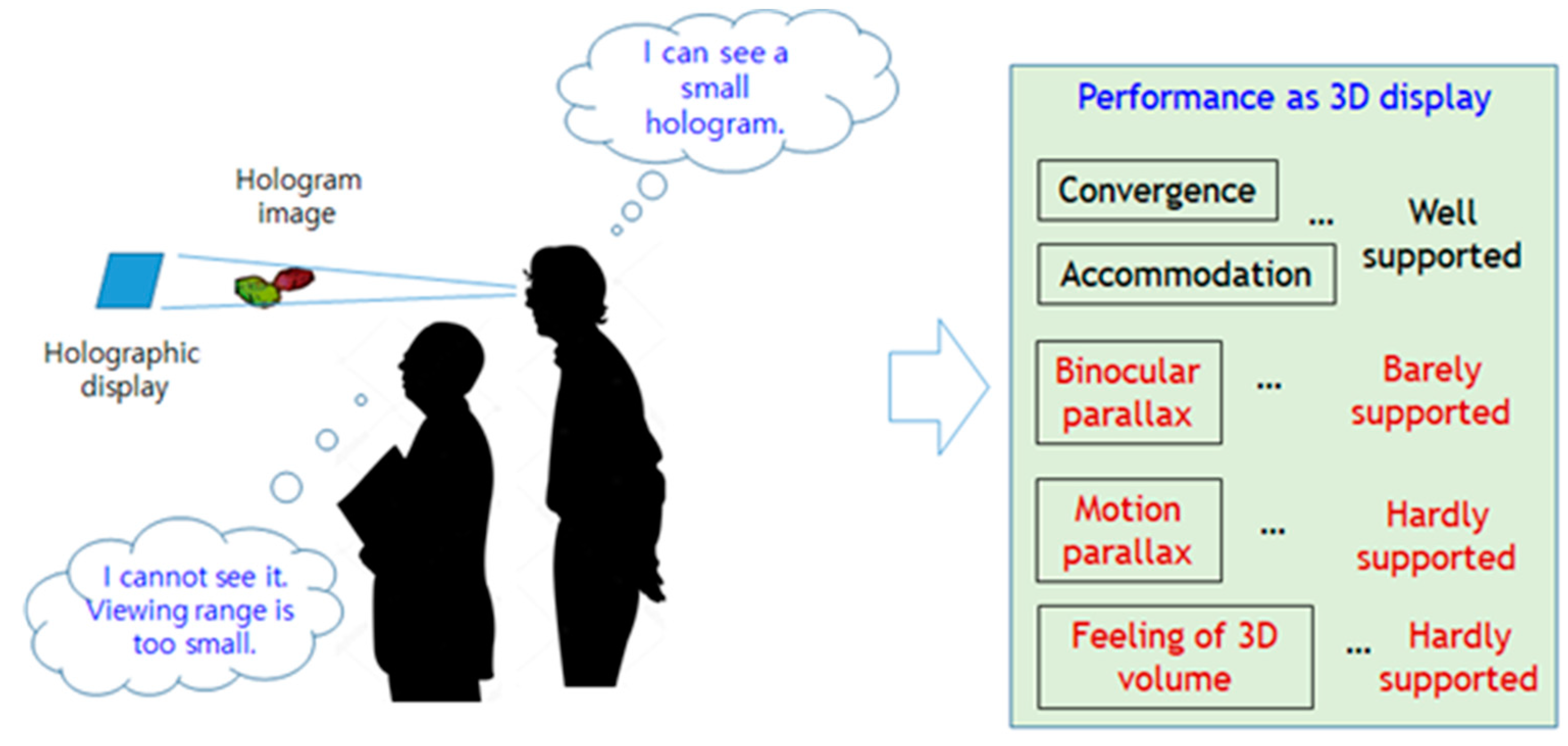

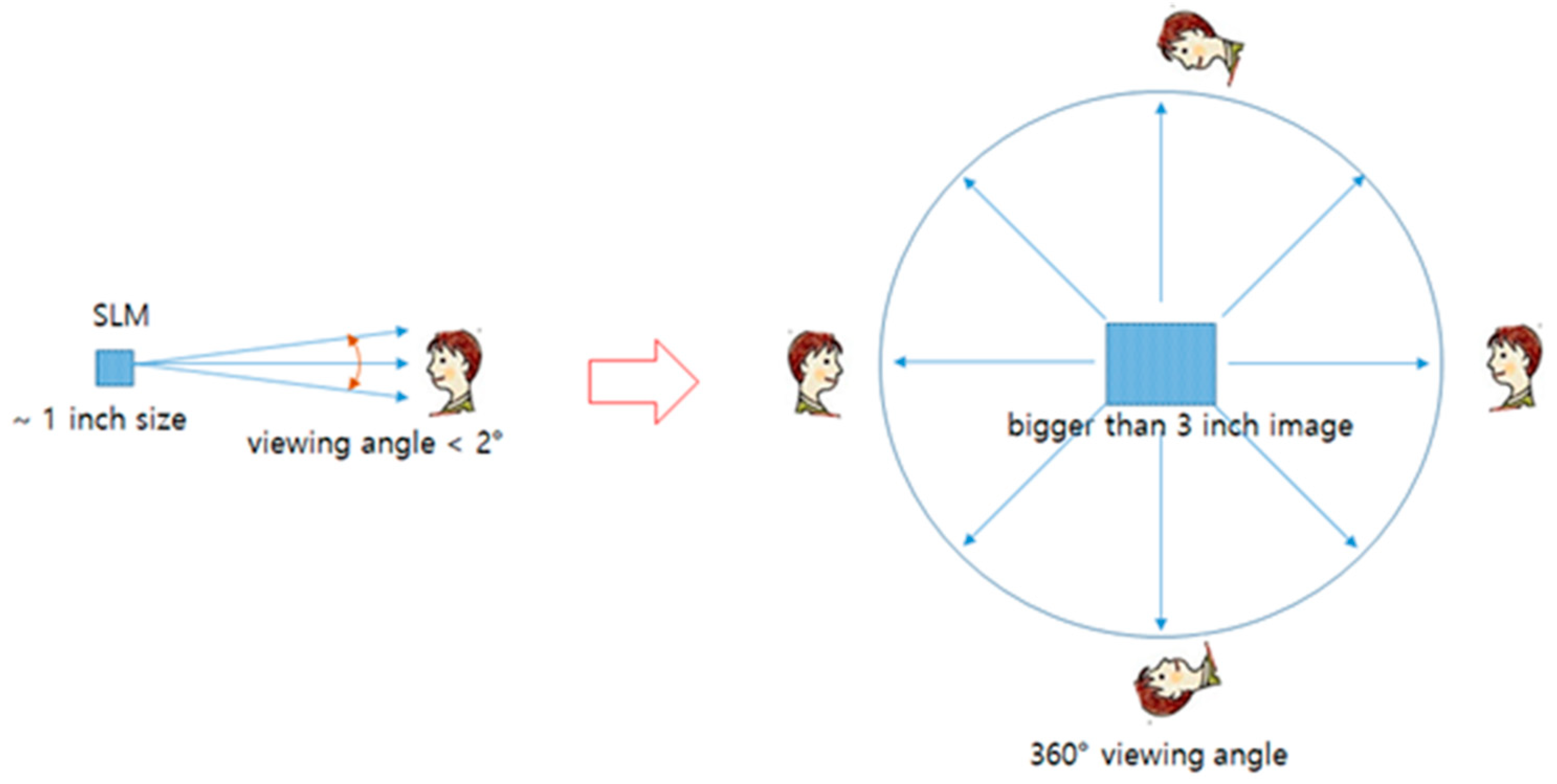

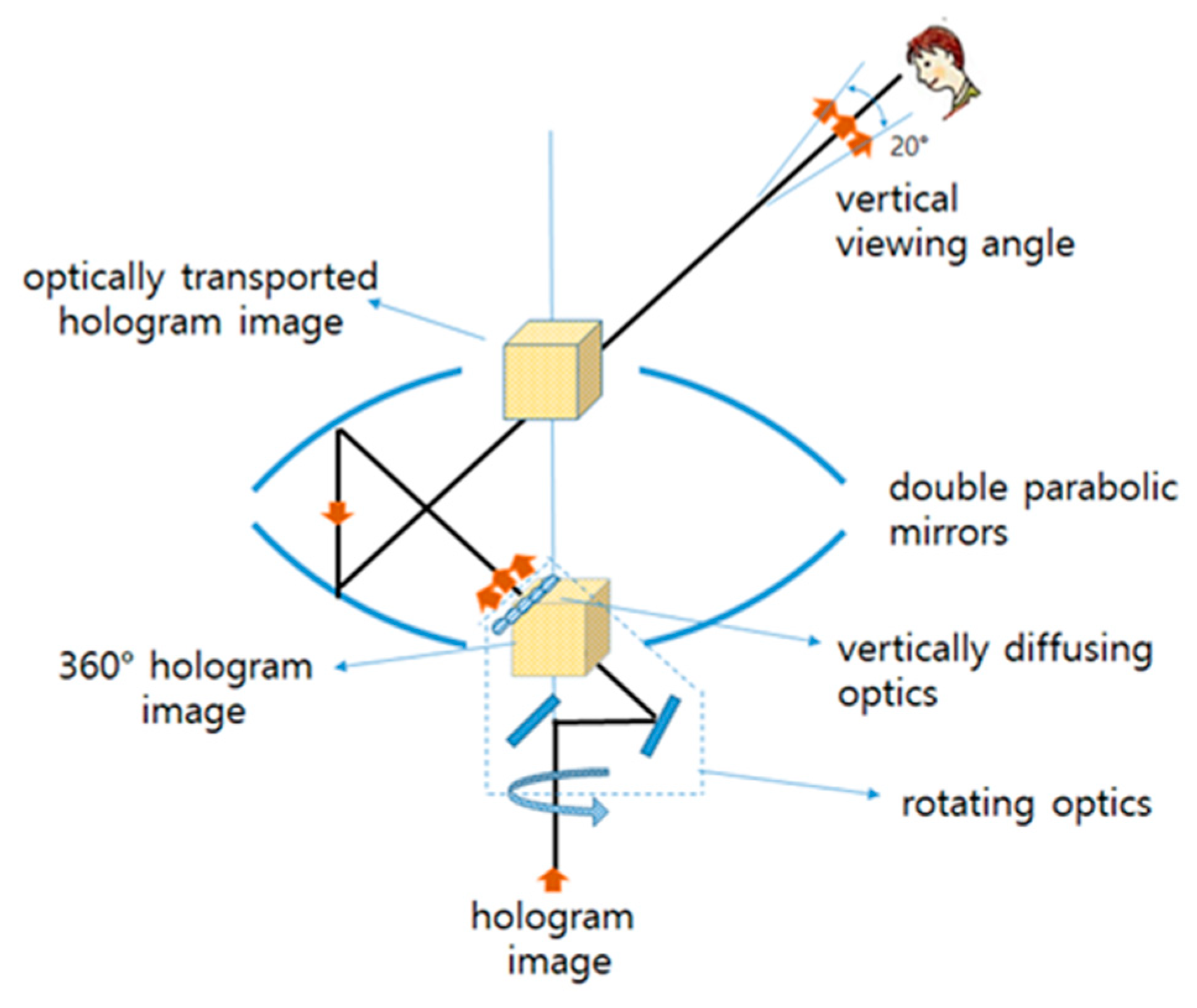
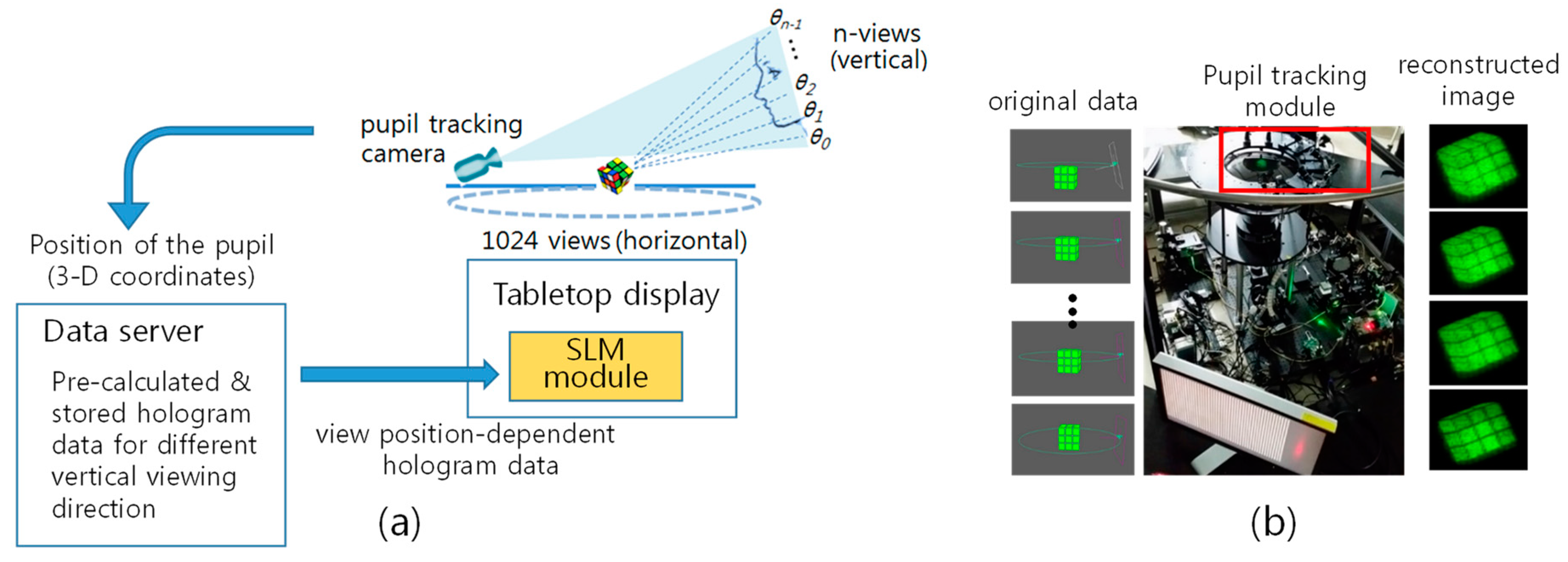




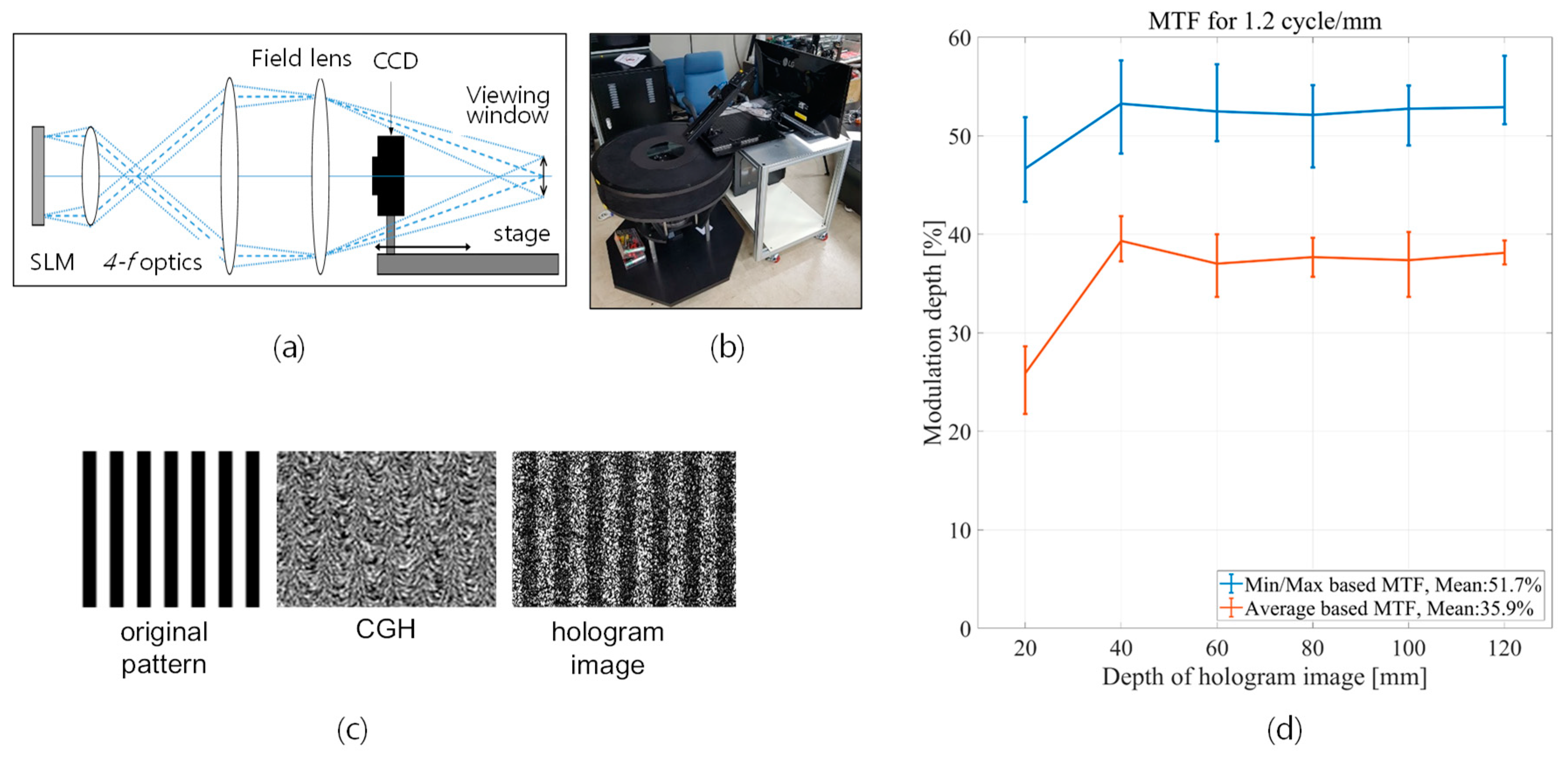


| Systems | SLM | Architecture | Characteristics | References |
|---|---|---|---|---|
| MIT Holo-video display (Mark-I, II, III, IV) | AOM | Multichannel mechanical scanning | P: HPO, C: MC (1992), FC (2012) | [2] [3] |
| SeeReal VISIO 20 | LCD (pixel pitch: ~100 um) | Viewing window tracking | P: HPO, ISD: 20 inch VA: NA (eye tracking) | [4] |
| SNU Curved holographic display | LCD | Curved spatial tiling of multiple LCDs | P:FP ISD: 0.5 inch VA: 22.8° | [5] |
| NICT Full color display | 4K LCoS | 4 × 4 spatial tiling | ISD: 85 mm VA: 5.6°, FR: 20 fps | [6] [7] |
| TUAT Horizontal scanning holography | DMD | Horizontal scanning with anamorphic system | P: HPO ISD: 6.2 inch VA: 10.2° | [8] [9] |
| Univ. of Arizona Rewritable printing display | Rewritable photorefractive polymer material | 6-ns pulsed laser at a rate of 50 Hz write, LEDs for readout | P: FP ISD: 12 inch VA: NAFR: 0.5 fps | [10] |
| ETRI | LCD (pixel pitch: ~120 um) | Viewing window tracking | P: FP ISD: 16 inch VA: NA (eye tracking) | [11] |
| Requirement | → | Specification |
|---|---|---|
| 1. Size of the hologram image | → | 7.63 cm or bigger |
| 2. 360 degree viewable freely by multiple users | → | Horizontal viewing angle 360 degrees Vertical viewing angle 20 degrees |
| 3. Volumetric image with full parallax | → | Floating image in the center of the display with 45 degrees of downward viewing direction |
| 4. Image should not occupy physical space | → | |
| 5. Color hologram video | → | R/G/B full color video rendering |
| SLM Type | Pixel Pitch (μm) | Pixel Resolution | SBP (Total Pixels) | Refresh Rate/bit Depth | eSBP (Total Data Rate) | eSBP Ratio | System |
|---|---|---|---|---|---|---|---|
| LCD | 156 × 52 | 2560 × 2048 | 5,242,880 | 60/8 | 2,516,582,400 | 0.63 | SeeReal |
| LCoS | 4.8 × 4.8 | 3840 × 2160 | 8,294,400 | 60/8 | 3,981,312,000 | 1 | NICT |
| DMD | 13.68 × 13.68 | 1024 × 768 | 786,432 | 32,000/1 | 25,165,824,000 | 6.32 | ETRI |
| Category | Metrics | Definition/Description |
|---|---|---|
| Image volume size | 3-dimensional volume (width × height × depth) | Maximally representable image size measured in lateral and depth direction, or equivalent |
| Viewing angle (VA) | Horizontal/vertical VA | Lateral or circular viewing range measured in angle |
| Image quality | 3D-MTF (image resolution) | MTF measured through depth range of image volume, which represents image resolution |
| Color fidelity | Color distortion measured for standard color chart | |
| Speckle noise | Speckle contrast measured | |
| Brightness | Perceptive brightness level of the image | |
| Support of accommodation | Degree of Depth of Focus (DOF) | The smaller the DOF, the better the capability of supporting accommodation |
© 2019 by the authors. Licensee MDPI, Basel, Switzerland. This article is an open access article distributed under the terms and conditions of the Creative Commons Attribution (CC BY) license (http://creativecommons.org/licenses/by/4.0/).
Share and Cite
Kim, J.; Lim, Y.; Hong, K.; Kim, H.; Kim, H.-E.; Nam, J.; Park, J.; Hahn, J.; Kim, Y.-j. Electronic Tabletop Holographic Display: Design, Implementation, and Evaluation. Appl. Sci. 2019, 9, 705. https://doi.org/10.3390/app9040705
Kim J, Lim Y, Hong K, Kim H, Kim H-E, Nam J, Park J, Hahn J, Kim Y-j. Electronic Tabletop Holographic Display: Design, Implementation, and Evaluation. Applied Sciences. 2019; 9(4):705. https://doi.org/10.3390/app9040705
Chicago/Turabian StyleKim, Jinwoong, Yongjun Lim, Keehoon Hong, Hayan Kim, Hyun-Eui Kim, Jeho Nam, Joongki Park, Joonku Hahn, and Young-ju Kim. 2019. "Electronic Tabletop Holographic Display: Design, Implementation, and Evaluation" Applied Sciences 9, no. 4: 705. https://doi.org/10.3390/app9040705
APA StyleKim, J., Lim, Y., Hong, K., Kim, H., Kim, H.-E., Nam, J., Park, J., Hahn, J., & Kim, Y.-j. (2019). Electronic Tabletop Holographic Display: Design, Implementation, and Evaluation. Applied Sciences, 9(4), 705. https://doi.org/10.3390/app9040705





